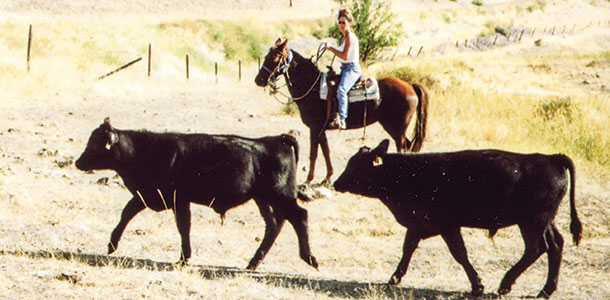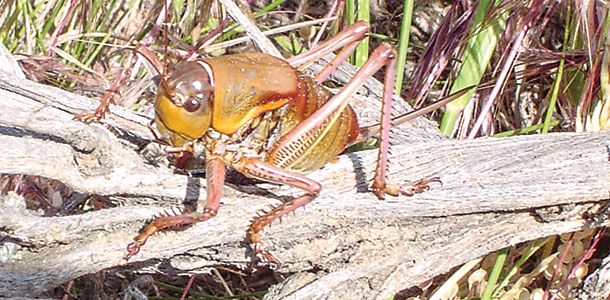In bad years, grasshopper suppression efforts can be beneficial. Since population explosions are progressive and cumulative, small interventions at the right time can curtail the population expansion and reduce subsequent damage to vegetation.
Paul Blom, Ph.D., entomologist with the Oregon Department of Agriculture, says these insects overwinter as eggs in the ground. In the spring they hatch, and their mortality rate depends on weather conditions through fall and winter and during spring when they are hatching. Spring weather plays a key role in the severity of an outbreak.
“Extreme cold can affect viability of the eggs over winter, and not as many will hatch out the next spring. But the largest mortality rate can occur in the spring if these young grasshoppers hatch out and there is nothing for them to eat.
“If it is a very wet spring, there would be plenty of forage, but extremely wet conditions can make them vulnerable to many pathogens and they don’t thrive,” he says.
Warm temperatures with little rainfall makes ideal conditions for hatching and development, whereas cool, wet conditions following the hatch are unfavorable to these insects’ growth and development.

“Probably the most important thing landowners and land managers can do, regarding pastures or crops, is to pay attention to the ground in early spring and try to notice where the hatch is located, and whether it is occurring with large numbers.
Some of the species that tend to have large outbreaks will have fairly consolidated egg beds. The ground in those areas will seem to be boiling with young grasshoppers,” says Blom.
“A species that is more diffuse will still be quite noticeable if it is going to cause problems. The immature insects are very tiny, but you can still see them if you look closely. In warm weather, they may be jumping around, but in cool weather they may be just sitting there, and you really have to pay attention to see them,” he says.
“We do a number of workshops to help people learn how to look for them. I’ve had ranchers tell me they didn’t have any that spring, and then I get a call from them a week or two later saying that all these grasshoppers are flying and hitting them on their ATV, etc. The young grasshoppers were there earlier, but the ranchers just didn’t know what to look for,” he explains.
It is important to notice them early, when they are small. “If there are a lot of them, that’s the time you can be most effective if you have to use chemical control. Then you won’t have to treat as large an area because they are still congregated near their egg beds. And if you use a product that has some residual effect, it will be more helpful because the hatch sometimes continues to occur over a couple of weeks,” says Blom.
Dr. Roger Gates, rangeland extension specialist, South Dakota State University West River Ag Center, says producers need to plan ahead, and the planning starts with anticipating what might be coming the next year.
“That’s not always easy to do, but in South Dakota APHIS (Animal Plant Health Inspection Service) always does adult grasshopper surveys in the fall and nymph surveys every spring. They are persistent in keeping track of grasshopper populations,” he says.
The nymph surveys use sweep nets, making 40 sweeps at each designated site. The adult surveys use a visual count of all hoppers on each square-foot site. These numbers help surveyors estimate population numbers for the current year and aid in forecasting future population – and identifying risk areas – for the following year.
Adult grasshopper density surveys provide a projection about what to anticipate for numbers the following spring. “APHIS people do this every year in western South Dakota and a couple eastern counties. In their 2014 surveys, they said numbers were the lowest they’d ever seen, and one of them has been doing this for 35 years,” says Gates.
“Anticipating numbers for 2015, the indications from this survey are that spring populations in South Dakota won’t be severe, but numbers are also affected by spring growing conditions. Hot, dry weather early in the year can enhance grasshopper activities and reproductive rates,” he explains.
Grazing management
In general, most things that are beneficial for grass management can also provide some benefits in minimizing the potential for grasshopper multiplication. Insects are cold-blooded, which means their body temperature is the same as the temperature of their surroundings.
“They control their body temperature by moving to a warmer or cooler area. If there are shady spots adjacent to bare ground, they can jump back and forth to control their body temperature. Grazing patterns and management that minimizes bare ground can be beneficial in modifying grasshopper population and slowing their multiplication,” says Gates.
“Rotational patterns that create more and more uniformly shaded areas (not grazing the forage down to the ground) are always a good practice. Rotational grazing can help mitigate grasshopper populations,” he says.

On public land, it can often be difficult to practice adequate rotational grazing or grasshopper control. “Working with agency people to make plans for long-term health of the range can be a start, but the drawback is that nothing happens very fast on public lands,” says Gates.
By the time everything is in place for a control program, for instance, the best window for controlling an exploding grasshopper population (when they are young and not expanding their territory very much yet) may be past.
Control programs
“As populations are tracked (and APHIS does this on public as well as private lands), if numbers are sufficiently high to put producers at risk, there are cost-share programs that are 100 percent on public land but only one-third on private land.
It is important to try to anticipate what might happen the next year. One of the big costs of control is application since a lot of it is done with aerial spray,” says Gates.
If neighbors work together so large areas can be treated, this reduces the cost for each individual and also reduces the risk for grasshoppers coming into your place from a neighboring ranch that did not control their hoppers. It pays to plan ahead and have an organized effort.
“Producers also need to recognize that grasshoppers are part of the normal fauna. Unless their numbers are high, we can live with them. They are an important food source for birds and other animals. Only a few species are a problem for agriculture. There are about 70 species in South Dakota, and only 10 are potential pests. They have specific dietary requirements. Some are grass-feeders and some eat forbs. A grasshopper that’s a problem in soybeans won’t be a problem in your pasture,” explains Gates.
“Grasshopper populations are analogous to drought, creating potential reduction in available feed supply. It is best if you can anticipate both and have contingency plans,” he says. ![]()
Heather Thomas is a field editor based in Idaho.
PHOTOS
PHOTO 1: On a dry year grasshoppers often compete with livestock and other animals for forage. Photo courtesy of Roger Gates.
PHOTO 2: On a dry year there are often more grasshoppers than on a wet year. Photo courtesy of Heather Thomas.
PHOTO 3: Mormon cricket. Photo courtesy of Bruce Shambaugh.
How much do grasshoppers eat?
Studies in South Dakota where grasshoppers were placed on native rangeland at a rate of 24 hoppers per square yard resulted in forage disappearance ranging from 120 to 150 pounds per acre per month, according to a fact sheet authored by Roger Gates (extension rangeland specialist, SDSU), Martin Beutler (extension range economist, SDSU) and Bruce Helbig (USDA-APHIS PPQ, South Dakota).
This equates to more than 400 pounds of forage per acre during the growing season, with an average loss of 16.7 pounds of forage per acre per grasshopper per square yard.
Research from other locations across different environments showed a loss of 5 to 18 pounds per acre of forage per grasshopper per square yard. To be cost-effective, the expense of applying an insecticide would have to be less than the value of forage lost.
As pointed out by the authors of the fact sheet, application on rangeland is more economical with government cost-share programs or strip applications. The goal of suppression efforts is to reduce populations to protect rangeland ecosystems or adjacent cropland, since hoppers often move from arid rangelands into nearby fields.







